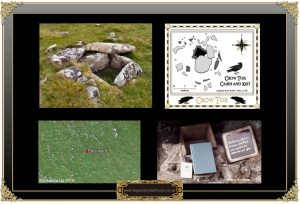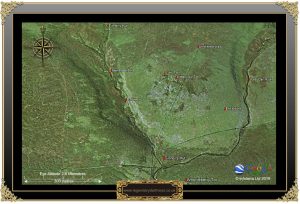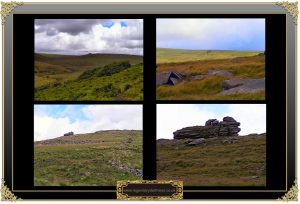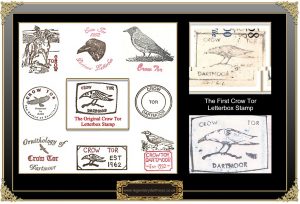
Just on the southern edge of Dartmoor’s northern fen is a small tor which when observed on the skyline presents a remarkable silhouette which is said to resemble a sitting bird, to be more precise a crow and hence the tor is known as Crow Tor. There is some unexplainable fascination with this granite outcrop which tends to make up for the lack of history or fable attached to it. Some people find the tor a jewel in the landscape whilst others tend to view the granite outcrop as a bizarre freak of nature , Hemery describes it as, ‘the grotesque Crow Tor‘. – p.229. The noted Dartmoor author Eden Phillpotts seems to have had some infinity with Crow Tor as it appears in two of his novels; ‘The Thief of Virtue’ and ‘The River’, in the former he describes the tor in the following way; “On a bog-founded slope above the gorges of Dart in mid-Moor stands Crow Tor, and seen from afar from beneath Wistman’s Wood, ascends as a prominent landmark among the hills. In form, at this remote range, it suggests some mighty saurian or hump-backed snail, creeping aloft from its lair in the marshes; while observed at hand, the tor presents an irregular, huge mass of granite plied forty feet above the earth, cleft, torn and weathered from base to crown. Upon one side the ledges overhang heavily and shut the sky from any who walk beneath them; the summit mounts northerly of this pent-house; and in the midst of the mass is a little plateau of vegetation, dwarfed almost to a carpet by its elevation and the ceaseless pressure of great winds.” – p. 327.
According to the English Place-Name Society the earliest mention of Crow Tor was in 1346 when it is called Crewtor, the following year the name had mutated to Crewtorre. – Glover et al. p.198. The old Anglo Saxon word – Crãw means ‘crow’, the feminine version is Crãwe, – Clark Hall, p. 74. Mrs Bray was still referring to the old names in 1836 and remarks, ‘… to these succeeded, towards the north, Crow or Croughter, and Little Crowtor‘. – p.122. It is interesting to see that in the 1890s Worth was still referring to the tor as Crowter – p.63.
Crow Tor sits at a lofty height of 486 metres and as can be imagined this can be a very exposed spot, especially in wintertime, It was reported that in the snow storm of February of 1939 a local farmer was out looking for his sheep when he came across a herd of ponies sheltering by the tor. All attempts to drive them off the moor was useless as in his words the snow was 20 foot deep in places.
Around the tor there is evidence of early man’s activities in the form of a well preserved kist with its retaining circle and an enclosure, both probably dating to the Bronze Age. Worth records that a worked flint scraper was discovered inside this kist although he gives no further information – p.197. Luckily Butler gives a bit more information and notes that the Dartmoor Exploration Committee found it in 1901. – p.277. The enclosure is best seen from the air where the perimeter wall and internal dividing banks can be seen. To the west of the tor are the remnants of several hut circles, again dating back to the Bronze Age. This is pure supposition but to early man the very shape of the tor must have had some sort of significance which made it a special place in their landscape? It is rather surprising that so little burial evidence has been found around the slopes of the tor.
Just to the south of the main outcrop is Crow Tor’s little relation simply known as Littel Crow tor. Crossing mentions the wall which lies to the south of the tor and explains that it’s the remnants of a late 18th century abortive attempt to enclose a tract of moorland which stretched as far north as Rough Tor – p.116. In some circles the newtake wall has become known as the ‘Unfinished Wall’, a fact that has not escaped the notice of letterboxers. In his opinion the newtake was intended to form part of the Rowter Farm, the ruined remains of which can still be found just about three quarters of a mile to the north-east of Crow Tor. The Ordnance Survey record the ruins as Browne’s House, seemingly after a previous occupant called Browne.
There is a smallish rock at the base of the main tor which has an enigmatic inscription, namely the initials ‘C’ and ‘T’ which presumably represent the name of Crow Tor. None of the main books on boundstones list this rock so it can be assumed that it is a recent addition for whatever reason. To the west of the tor is a small stream which runs down through a tract of land recorded by the Ordnance Survey as Foxholes. However, Hemery (1983, p.406) considers that Dart Hole is the traditional place-name and that the stream was known as the Methern Brook or Foxholes Water. Either way, there is plenty of evidence that at one time the Dartmoor tinner was busy extracting tin from the streamworks. Near the head of the brook are the remnants of a tinner’s hut which today appears as low turf covered walls which enclose an area 1.7m by 1.5m. These small stone-built huts were used by the tinners to store their tools and equipment plus to provide some kind of shelter from the moorland elements. Whilst on the subject of foxes, from the very name Fox Holes one could imply that this was an area frequented by foxes and if you read many of the local hunt reports many state of finding one around Crow Tor, some actually being put up from the clitter below the tor,
Crow Tor was introduced to the world of letterboxing by having the third established box sited in 1962 and included a fine harbound visitors book which is now lodged along with later ones in Plymouth library. A rather unimpressed Eric Hemery commented that: “The shelter provided by the huge canopy to the rock core below has produced interesting contrasts in weathering effects. It has also produced another -post-box, which lies beneath the canopy in the natural chamber, the canister contains the usual paraphernalia, including a rubber stamp giving the image of a crow… The chamber was made more weather-proof by the use of cement, by ‘MIK’ and J. SPENCER on 16 xi 58‘. – p.407.
A selection of letterbox stamps that I have collected over the years from Crow Tor can be seen in figure 10 below. The original stamp had long disappeared by the time I began boxing but I did manage to find an old OS map which had a copy of the stamp on it as can be seen above.
![]()

Bray, E. 1836. A Description of the Part of Devonshire Bordering on the Tamar and The Tavy. London: J. Murray.
Butler, J. 1997. Dartmoor Atlas of Antiquities – Vol. V. Exeter: Devon Books.
Butler, J. 1991. Dartmoor Atlas of Antiquities – Vol. II. Exeter: Devon Books.
Clark Hall, J. R. 2004. A Concise Anglo-Saxon Dictionary. London: University of Toronto Press.
Crossing, W. 1990. Crossing’s Guide to Dartmoor. Newton Abbot: Peninsula Press.
Day, K. 1981. Eden Phillpotts on Dartmoor. Newton Abbot: David and Charles.
Gover, J. E. B., Mawer, A. & Stenton, F. M. 1992. The Place Names of Devon. Nottingham: English Place-Name Society.
Hemery, E. 1986. Walking Dartmoor’s Ancient Tracks. London: Robert Hale.
Hemery, E. 1983. High Dartmoor. London: Robert Hale.
Phillpotts, E. 1910. The Thief of Virtue. New York: John Lane Co.
Worth, R. N. 1988. Worth’s Dartmoor. Newton Abbot: David & Charles.
 Legendary Dartmoor The many aspects past and present of Dartmoor
Legendary Dartmoor The many aspects past and present of Dartmoor




